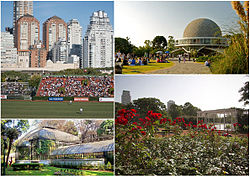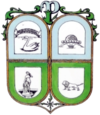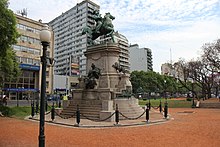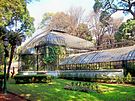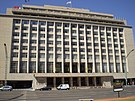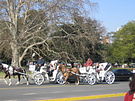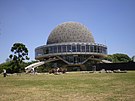
Florida Street is a popular shopping street in Downtown Buenos Aires, Argentina. A pedestrian street since 1971, some stretches have been pedestrianized since 1913.

Belgrano is a northern and leafy barrio or neighborhood of Buenos Aires, Argentina.

Balvanera is a barrio or neighborhood of Buenos Aires, Argentina.

Núñez is a barrio or neighbourhood of Buenos Aires, Argentina. It is on the northern edge of the city on the banks of the Rio de la Plata. The barrio of Belgrano is to the southeast; Saavedra and Coghlan are to the west; and Vicente López, in Buenos Aires Province, is to the north.

Recoleta is a barrio or neighborhood of Buenos Aires, Argentina, located in the northern part of the city, by the Río de la Plata. The area is perhaps best known to be the home of the distinguished Recoleta Cemetery. It is a traditional upper-class and conservative neighborhood with some of the priciest real estate in the city, known for Paris-style townhouses, lavish former palaces and posh boutiques.
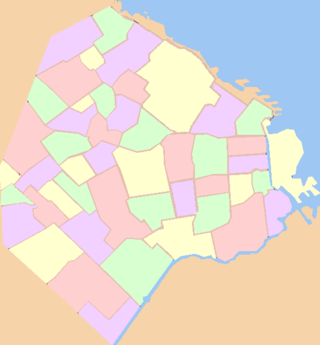
Buenos Aires, autonomous city and capital of Argentina, is composed of forty-eight neighborhoods. Since 2008, the city is also legally divided into communes, each one including one or more barrios. Among the most visited and populated barrios are Palermo, Recoleta, Puerto Madero, Belgrano, San Telmo, La Boca, Monserrat and Caballito. Sectors of the city are also traditionally known as neighborhoods by the inhabitants of Buenos Aires, but not officially by the authorities of the city; some examples include Chinatown, Barrio Norte and the Microcentro.

July 9 Avenue is a major thoroughfare in the city centre of Buenos Aires, Argentina. Its name honors Argentina's Independence Day, July 9, 1816.

Retiro is a barrio or neighborhood in Buenos Aires, Argentina. Located in the northeast end of the city, Retiro is bordered on the south by the Puerto Madero and San Nicolás, and on the west by the Recoleta.
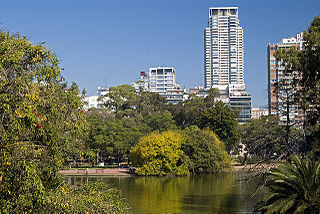
Parque Tres de Febrero, popularly known as Bosques de Palermo, is an urban park of approximately 400 hectares located in the neighborhood of Palermo in Buenos Aires, Argentina. Located between Libertador and Figueroa Alcorta Avenues, it is known for its groves, lakes, and rose gardens.

According to the World Travel & Tourism Council (WTTC) the travel and tourism sector of Argentina was moving towards recovering its pre-covid pandemic contribution to GDP in mid-2023, led by Buenos Aires.

Barrio Norte is the informal name given to a part of Buenos Aires centering on Santa Fe Avenue and the district of Recoleta.

The General Bartolomé Mitre Railway (FCGBM), named after the former Argentine president Bartolomé Mitre, is one of the six state-owned Argentine railway lines formed after President Juan Perón's nationalisation of the railway network in 1948 and one of the largest of Argentina. The six divisions, managed by Ferrocarriles Argentinos were later broken up during the process of railway privatisation beginning in 1991 during Carlos Menem's presidency.
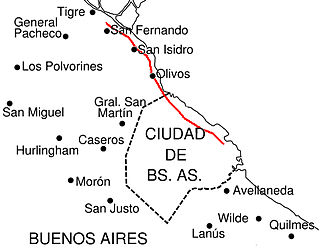
Avenida del Libertador is one of the principal thoroughfares in Buenos Aires, Argentina, and in points north, extending 25 km (16 mi) from the Retiro District of Buenos Aires to the northern suburb of San Fernando.

Avenida Santa Fe is one of the principal thoroughfares in Buenos Aires, Argentina. The artery is essential to the imaginary axis of Barrio Norte in Buenos Aires, comprising the areas influenced by the route of the avenue through Retiro, Recoleta and Palermo neighborhoods, it is considered one of the main shopping and strolling areas of the city, its many boutiques range from elegant to edgy, which has led it to be dubbed the 'Avenue of Fashion'. Upscale Alto Palermo, at Avenida Coronel Díaz, is one of the city's best-known vertical malls. Avenida Santa Fe is also an attraction for its architecture, strongly reminiscent of Paris. Its name pays homage to the eponymous province in Argentina.

Avenida Figueroa Alcorta is a major thoroughfare in Buenos Aires, Argentina, with a length of over 7 km (4.3 mi) along the city's northside.
The Buenos Aires Japanese Gardens are a public space administered by the non-profit Japanese Argentine Cultural Foundation in Buenos Aires, Argentina. They are among the largest Japanese gardens in the world outside Japan.

The Buenos Aires Central Business District is the main commercial centre of Buenos Aires, Argentina, though not an official city ward. While the barrios of Puerto Madero and Retiro house important business complexes and modern high-rise architecture, the area traditionally known as Microcentro is located within San Nicolás and Monserrat, roughly coinciding with the area around the historic center of the Plaza de Mayo. The Microcentro has a wide concentration of offices, service companies and banks, and a large circulation of pedestrians on working days. Another name given to this unofficial barrio is La City, which refers more precisely to an even smaller sector within the Microcentro, where almost all the banking headquarters of the country are concentrated.
The Plaza de Pakistán is a landmark in Buenos Aires, Argentina, commemorating Argentine–Pakistani friendship. It is located in the heart of Parque Tres de Febrero in the neighborhood of Palermo. It was redesigned in 2012 and inaugurated on July 27, 2012 by ambassador Naela Chohan of Pakistan and minister Diego Santilli of the Autonomous City of Buenos Aires, to commemorate the 60th anniversary of the establishment of the diplomatic relations between the two friendly countries. The park holds at its center a plaque with an engraving of a verse by Allama Iqbal (1877-1938), the national poet of Pakistan, emphasizing the importance of love for humanity both in Persian and Spanish.

Avenida General Sarmiento is an avenue located in the Palermo neighborhood, in Buenos Aires, Argentina. It runs from Plaza Italia to the Costanera Rafael Obligado Avenue, across the Parque Tres de Febrero.

Recoleta railway station was a railway station in the Recoleta district of Buenos Aires, Argentina. It was opened and operated by the Buenos Aires Northern Railway since 1862, as part of the Central Station – Belgrano R line. The railway would later extend to Tigre.
